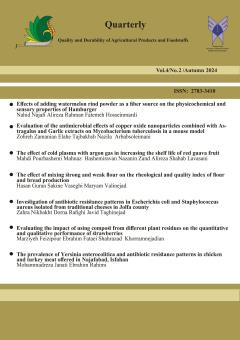اثر اختلاط آرد قوی و ضعیف بر شاخص رِئولوژیکی و کیفی آرد و نان تولیدی
الموضوعات : فصلنامه کیفیت و ماندگاری تولیدات کشاورزی و مواد غذاییحسن گوران 1 , سکینه واثقی 2 , مریم ولی نژاد 3
1 - کارشناسی ارشد، گروه کشاورزی و منابع طبیعی، واحد سوادکوه، دانشگاه آزاد اسلامی، سوادکوه، ایران
2 - استادیار، گروه کشاورزی و منابع طبیعی، واحد سوادکوه، دانشگاه آزاد اسلامی، سوادکوه، ایران
3 - استادیار، گروه کشاورزی و منابع طبیعی، واحد سوادکوه، دانشگاه آزاد اسلامی، سوادکوه، ایران
الکلمات المفتاحية: کیفیت آرد, اختلاط آرد, آرد ضعیف, آرد قوی,
ملخص المقالة :
آرد و نان سهم زیادی از سفره و رژیم غذایی ایرانیان را تشکیل میدهد؛ اما ضعیف بودن گندمهای تولیدی کشور، از مشکلات همیشگی صنعت آرد و نان میباشد که عامل مشکلات فراوانی در این صنعت شده است و اختلاط آرد همواره بهعنوان راهکار اصلی اجرا میشود. در تحقیق حاضر، اختلاط آرد قوی با آرد ضعیف در نسبتهای مختلف و اثر آن بر شاخصهای مختلف کیفی آرد و نان تولیدی، بررسی گردید. ابتدا نمونههاي آرد 18 درصد از واريته گندم سرداري كه از ارقام ضعيف گندم میباشد، تهيه و به نسبتهاي 20-80، 30-70، 50-50، 70-30 و 80-20 درصد با آرد 18 درصد با نمونه گندم قوي رقم 19-80N اختلاط شده و شاخصهاي رئولوژيكي و كيفي (شامل درصد گلوتن مرطوب، درصد گلوتن خشك، انديس گلوتن، آزمون زلني، فالينگ نامبر، درصد خاكستر، درصد رطوبت، اندازهگيري رنگ آرد با تكنيك پردازش تصوير) بررسي شد. نتایج نشان داد که تیمار اختلاط 70 درصد آرد ضعیف با 30 درصد آرد قوی، به دلیل بالا بودن کلیه شاخصهای مربوط به آرد و نان شامل: درصد گلوتن خشک و مرطوب، اندیس گلوتن، عدد زلنی و فالینگ، درصد خاکستر و رطوبت و پروتئین، بافت، عطر و بو، قابلیت جویدن، تخلخل، شکل ظاهر و شاخصهای رنگ نان، نسبت به سایر اختلاطها و نیز عدم اختلاف معنیدار نسبت به اختلاطهای با درصد آرد قوی بالاتر، میتواند بهعنوان بهترین اختلاط پیشنهاد گردد.
1- Cui T, Zhou X, Sui W, Liu R, Wu T, Wang S, Jin Y, Zhang M. Effects of thermal-induced konjac glucomannan-protein interaction on structural and rheological properties of wheat dough. Food Structure. 2022; 33:100288.
2- Amini M, Afshin Pajoh R, Jamali V. Investigating the effect of thermal process on the rheological properties of dough. 21st National Food Industry Congress.2012. (In Persian)
3- Bahrami, M. Shahedi. The Effect of Wheat Cultivar, Flour Extraction Rate and Baking Duration and Temperature on Dough Rheological Properties, Bread Staling and Organoleptic Properties. Journal of Crop Production and Processing 2004; 8 (1):195-204.
4- Nasehi B, Tahanejad M. Characteristics of the chemical, sensory and microbial of the flours in Khuzestan. Journal of food science and industry. 2014; 11(45): 77-84. (In Persian).
5- Sahraiyan B, Mazaheri Tehrani M, Naghipour F, Ghiafeh Davoodi M, Soleimani M. The effect of mixing wheat flour with rice bran and soybean flour on physicochemical and sensory properties of baguettes. Iranian Journal of Nutrition Sciences and Food Technology. 2013; 8 (3):229-240. (In Persian).
6- Mirmajidi A, and Abbasi S.Effect of Wheat Cultivar and Wheat Flour Ratio on Physicochemical Properties of Samanoo, Journal of Agricultural Engineering Research, 2012; 13(1):56-45. (In Persian).
7- Poursafar L, Peighambardoust S.H, Alizadeh Shalchi L, Shakuoie Bonab E, Rafat S.A. Effect of the temperature and time of flour heat treatment on the quality characteristics of sponge cake, Electronic Journal of Food Processing and Preservation.2011; 2 (4): 87-104(In Persian).
8- De Bondt Y, Hermans W, Moldenaers P, Courtin CM. Selective modification of wheat bran affects its impact on gluten-starch dough rheology, microstructure and bread volume. Food Hydrocolloids. 2021; 113:106348.
9- Raftani AZ, Shamshirsaz M. Improve the quality of wheat flour by determination of mixing ratio of Morvarid (Kordkoy area) and Bezostaya wheat varieties. Food Science and Technology;2017;14(3): 339-346. (In Persian).
10- Apichartsrangkoon A, Bell A, Ledward D, Schofield JD. Dynamic Viscoelastic Behavior of High-Pressure-Treated Wheat Gluten. Cereal Chemistry. 1999; 76. 10.1094/CCHEM.1999.76.5.777.
11- Niu M, Hou G, Lee G, Chen Z, Effects of fine grinding of millfeeds on the quality attributes of reconstituted whole-wheat flour and its raw noodle products. LWT - Food Science and Technology.2014: 57. 58-64.
12- Marti A, Torri L, Casiraghi M C, Franzetti, L., Limbo S, Morandin F, Quaglia L, Pagani MA. Wheat germ stabilization by heat-treatment or sourdough fermentation: Effects on dough rheology and bread properties. LWT - Food Science and Technology.2014: 59 (2): 1100-1106.
13- Yazar, G. Wheat Flour Quality Assessment by Fundamental Non-Linear Rheological Methods: A Critical Review. Foods 2023; 12(18):3353.
14- Cappelli A, Bettaccini L, Cini E. The kneading process: A systematic review of the effects on dough rheology and resulting bread characteristics, including improvement strategies. Trends in Food Science & Technology. 2020; 104:91-101.
15- Sun X, Wu S, Koksel F, Xie M, Fang Y. Effects of ingredient and processing conditions on the rheological properties of whole wheat flour dough during breadmaking-A review.
16- Food Hydrocolloids. 2023; 135:108123.


